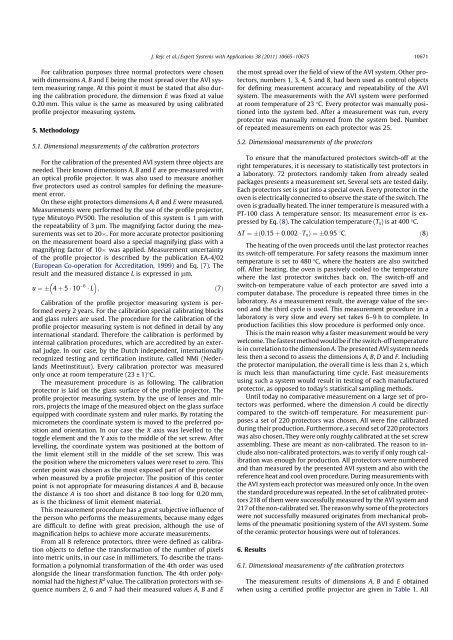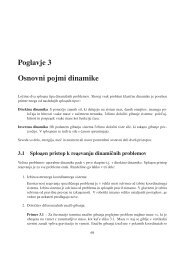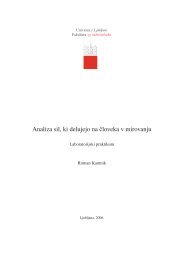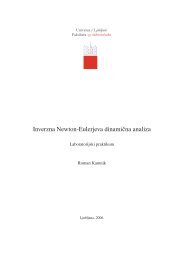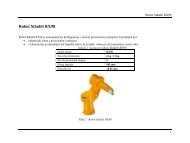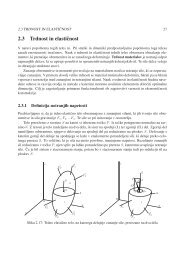The mechanical assembly dimensional measurements with the ...
The mechanical assembly dimensional measurements with the ...
The mechanical assembly dimensional measurements with the ...
Create successful ePaper yourself
Turn your PDF publications into a flip-book with our unique Google optimized e-Paper software.
J. Rejc et al. / Expert Systems <strong>with</strong> Applications 38 (2011) 10665–10675 10671For calibration purposes three normal protectors were chosen<strong>with</strong> dimensions A, B and E being <strong>the</strong> most spread over <strong>the</strong> AVI systemmeasuring range. At this point it must be stated that also during<strong>the</strong> calibration procedure, <strong>the</strong> dimension E was fixed at value0.20 mm. This value is <strong>the</strong> same as measured by using calibratedprofile projector measuring system.5. Methodology5.1. Dimensional <strong>measurements</strong> of <strong>the</strong> calibration protectorsFor <strong>the</strong> calibration of <strong>the</strong> presented AVI system three objects areneeded. <strong>The</strong>ir known dimensions A, B and E are pre-measured <strong>with</strong>an optical profile projector. It was also used to measure ano<strong>the</strong>rfive protectors used as control samples for defining <strong>the</strong> measurementerror.On <strong>the</strong>se eight protectors dimensions A, B and E were measured.Measurements were performed by <strong>the</strong> use of <strong>the</strong> profile projector,type Mitutoyo PV500. <strong>The</strong> resolution of this system is 1 lm <strong>with</strong><strong>the</strong> repeatability of 3 lm. <strong>The</strong> magnifying factor during <strong>the</strong> <strong>measurements</strong>was set to 20. For more accurate protector positioningon <strong>the</strong> measurement board also a special magnifying glass <strong>with</strong> amagnifying factor of 10 was applied. Measurement uncertaintyof <strong>the</strong> profile projector is described by <strong>the</strong> publication EA-4/02(European Co-operation for Accreditation, 1999) and Eq. (7). <strong>The</strong>result and <strong>the</strong> measured distance L is expressed in lm.u ¼ 4 þ 5 10 6 L ; ð7ÞCalibration of <strong>the</strong> profile projector measuring system is performedevery 2 years. For <strong>the</strong> calibration special calibrating blocksand glass rulers are used. <strong>The</strong> procedure for <strong>the</strong> calibration of <strong>the</strong>profile projector measuring system is not defined in detail by anyinternational standard. <strong>The</strong>refore <strong>the</strong> calibration is performed byinternal calibration procedures, which are accredited by an externaljudge. In our case, by <strong>the</strong> Dutch independent, internationallyrecognized testing and certification institute, called NMi (NederlandsMeetinstituut). Every calibration protector was measuredonly once at room temperature (23 ± 1)°C.<strong>The</strong> measurement procedure is as following. <strong>The</strong> calibrationprotector is laid on <strong>the</strong> glass surface of <strong>the</strong> profile projector. <strong>The</strong>profile projector measuring system, by <strong>the</strong> use of lenses and mirrors,projects <strong>the</strong> image of <strong>the</strong> measured object on <strong>the</strong> glass surfaceequipped <strong>with</strong> coordinate system and ruler marks. By rotating <strong>the</strong>micrometers <strong>the</strong> coordinate system is moved to <strong>the</strong> preferred positionand orientation. In our case <strong>the</strong> X axis was levelled to <strong>the</strong>toggle element and <strong>the</strong> Y axis to <strong>the</strong> middle of <strong>the</strong> set screw. Afterlevelling, <strong>the</strong> coordinate system was positioned at <strong>the</strong> bottom of<strong>the</strong> limit element still in <strong>the</strong> middle of <strong>the</strong> set screw. This was<strong>the</strong> position where <strong>the</strong> micrometers values were reset to zero. Thiscenter point was chosen as <strong>the</strong> most exposed part of <strong>the</strong> protectorwhen measured by a profile projector. <strong>The</strong> position of this centerpoint is not appropriate for measuring distances A and B, because<strong>the</strong> distance A is too short and distance B too long for 0.20 mm,as is <strong>the</strong> thickness of limit element material.This measurement procedure has a great subjective influence of<strong>the</strong> person who performs <strong>the</strong> <strong>measurements</strong>, because many edgesare difficult to define <strong>with</strong> great precision, although <strong>the</strong> use ofmagnification helps to achieve more accurate <strong>measurements</strong>.From all 8 reference protectors, three were defined as calibrationobjects to define <strong>the</strong> transformation of <strong>the</strong> number of pixelsinto metric units, in our case in millimeters. To describe <strong>the</strong> transformationa polynomial transformation of <strong>the</strong> 4th order was usedalongside <strong>the</strong> linear transformation function. <strong>The</strong> 4th order polynomialhad <strong>the</strong> highest R 2 value. <strong>The</strong> calibration protectors <strong>with</strong> sequencenumbers 2, 6 and 7 had <strong>the</strong>ir measured values A, B and E<strong>the</strong> most spread over <strong>the</strong> field of view of <strong>the</strong> AVI system. O<strong>the</strong>r protectors,numbers 1, 3, 4, 5 and 8, had been used as control objectsfor defining measurement accuracy and repeatability of <strong>the</strong> AVIsystem. <strong>The</strong> <strong>measurements</strong> <strong>with</strong> <strong>the</strong> AVI system were performedat room temperature of 23 °C. Every protector was manually positionedinto <strong>the</strong> system bed. After a measurement was run, everyprotector was manually removed from <strong>the</strong> system bed. Numberof repeated <strong>measurements</strong> on each protector was 25.5.2. Dimensional <strong>measurements</strong> of <strong>the</strong> protectorsTo ensure that <strong>the</strong> manufactured protectors switch-off at <strong>the</strong>right temperatures, it is necessary to statistically test protectors ina laboratory. 72 protectors randomly taken from already sealedpackages presents a measurement set. Several sets are tested daily.Each protectors set is put into a special oven. Every protector in <strong>the</strong>oven is electrically connected to observe <strong>the</strong> state of <strong>the</strong> switch. <strong>The</strong>oven is gradually heated. <strong>The</strong> inner temperature is measured <strong>with</strong> aPT-100 class A temperature sensor. Its measurement error is expressedby Eq. (8). <strong>The</strong> calculation temperature (T x ) is at 400 °C.DT ¼0:15 ð þ 0:002 T x Þ ¼ 0:95 C: ð8Þ<strong>The</strong> heating of <strong>the</strong> oven proceeds until <strong>the</strong> last protector reachesits switch-off temperature. For safety reasons <strong>the</strong> maximum innertemperature is set to 480 °C, where <strong>the</strong> heaters are also switchedoff. After heating, <strong>the</strong> oven is passively cooled to <strong>the</strong> temperaturewhere <strong>the</strong> last protector switches back on. <strong>The</strong> switch-off andswitch-on temperature value of each protector are saved into acomputer database. <strong>The</strong> procedure is repeated three times in <strong>the</strong>laboratory. As a measurement result, <strong>the</strong> average value of <strong>the</strong> secondand <strong>the</strong> third cycle is used. This measurement procedure in alaboratory is very slow and every set takes 6–9 h to complete. Inproduction facilities this slow procedure is performed only once.This is <strong>the</strong> main reason why a faster measurement would be verywelcome. <strong>The</strong> fastest method would be if <strong>the</strong> switch-off temperatureis in correlation to <strong>the</strong> dimension A. <strong>The</strong> presented AVI system needsless <strong>the</strong>n a second to assess <strong>the</strong> dimensions A, B, D and F. Including<strong>the</strong> protector manipulation, <strong>the</strong> overall time is less than 2 s, whichis much less than manufacturing time cycle. Fast <strong>measurements</strong>using such a system would result in testing of each manufacturedprotector, as opposed to today’s statistical sampling methods.Until today no comparative measurement on a large set of protectorswas performed, where <strong>the</strong> dimension A could be directlycompared to <strong>the</strong> switch-off temperature. For measurement purposesa set of 220 protectors was chosen. All were fine calibratedduring <strong>the</strong>ir production. Fur<strong>the</strong>rmore, a second set of 220 protectorswas also chosen. <strong>The</strong>y were only roughly calibrated at <strong>the</strong> set screwassembling. <strong>The</strong>se are meant as non-calibrated. <strong>The</strong> reason to includealso non-calibrated protectors, was to verify if only rough calibrationwas enough for production. All protectors were numberedand than measured by <strong>the</strong> presented AVI system and also <strong>with</strong> <strong>the</strong>reference heat and cool oven procedure. During <strong>measurements</strong> <strong>with</strong><strong>the</strong> AVI system each protector was measured only once. In <strong>the</strong> oven<strong>the</strong> standard procedure was repeated. In <strong>the</strong> set of calibrated protectors218 of <strong>the</strong>m were successfully measured by <strong>the</strong> AVI system and217 of <strong>the</strong> non-calibrated set. <strong>The</strong> reason why some of <strong>the</strong> protectorswere not successfully measured originates from <strong>mechanical</strong> problemsof <strong>the</strong> pneumatic positioning system of <strong>the</strong> AVI system. Someof <strong>the</strong> ceramic protector housings were out of tolerances.6. Results6.1. Dimensional <strong>measurements</strong> of <strong>the</strong> calibration protectors<strong>The</strong> measurement results of dimensions A, B and E obtainedwhen using a certified profile projector are given in Table 1. All


